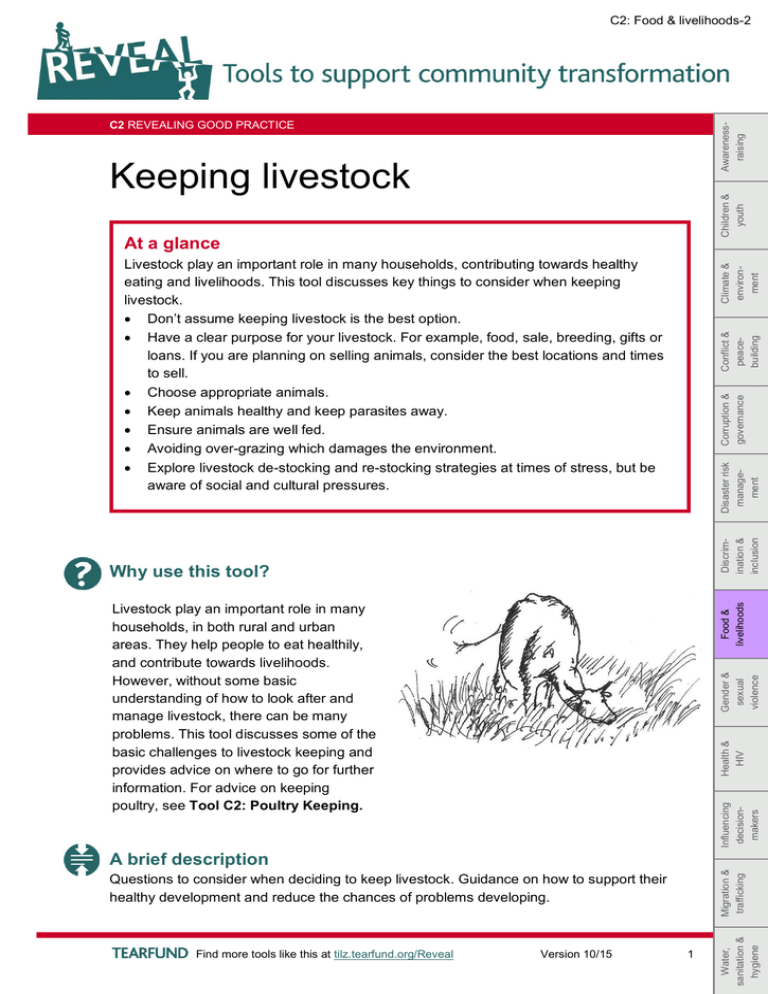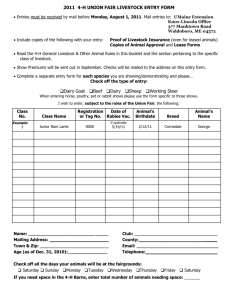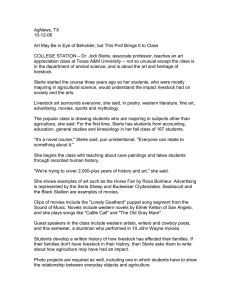Document 10783773
advertisement

C2: Food & livelihoods-2 Awarenessraising C2 REVEALING GOOD PRACTICE Children & youth Keeping livestock At a glance Discrimination & inclusion Disaster risk management Corruption & governance Conflict & peacebuilding Climate & environment Livestock play an important role in many households, contributing towards healthy eating and livelihoods. This tool discusses key things to consider when keeping livestock. Don’t assume keeping livestock is the best option. Have a clear purpose for your livestock. For example, food, sale, breeding, gifts or loans. If you are planning on selling animals, consider the best locations and times to sell. Choose appropriate animals. Keep animals healthy and keep parasites away. Ensure animals are well fed. Avoiding over-grazing which damages the environment. Explore livestock de-stocking and re-stocking strategies at times of stress, but be aware of social and cultural pressures. Food & livelihoods Why use this tool? Influencing decisionmakers Health & HIV Gender & sexual violence Livestock play an important role in many households, in both rural and urban areas. They help people to eat healthily, and contribute towards livelihoods. However, without some basic understanding of how to look after and manage livestock, there can be many problems. This tool discusses some of the basic challenges to livestock keeping and provides advice on where to go for further information. For advice on keeping poultry, see Tool C2: Poultry Keeping. Questions to consider when deciding to keep livestock. Guidance on how to support their healthy development and reduce the chances of problems developing. Find more tools like this at tilz.tearfund.org/Reveal Version 10/15 1 Water, sanitation & hygiene Migration & trafficking A brief description C2: Food & livelihoods-2 C2 KEEPING LIVESTOCK Awarenessraising Explaining the words we use Children & youth Livestock – usually means domestic animals such as cattle, buffalo, camels, goats, sheep, pigs, horses, mules, donkeys, rabbits, chickens and other fowl such as guinea fowl or duck. The term may also include guinea pigs, llamas and deer, but not usually fish or bees Community-based animal health worker (CBAHW) / para-vet – someone from the community who has received basic training in animal health and gives help and advice to people with sick animals Draught animals – an animal used for pulling a plough or other agricultural equipment Parasite – a living thing which feeds off another animal or plant. Livestock parasites are small pests which live by taking nutrients from the animal they live on Fodder – food for cattle and other livestock Climate & environment Conflict & peacebuilding Corruption & governance Why keep livestock? Disaster risk management Discrimination & inclusion Food & livelihoods Gender & sexual violence Health & HIV For the transport of people and goods such as water or firewood As draught animals to help cultivate agricultural land For animal products including meat, milk and eggs for consumption or sale. (Animal products are highly nutritious, which is particularly important for pregnant and lactating women and for children.) To use to barter for other products. For skin / hides / feathers / bone for sale or use in the household. For social occasions such as weddings or as loans to others in the community. In some cultures the number of livestock also reflects the household’s social status For religious festivals, although our work with communities should be careful to not encourage animal cruelty To help accumulate wealth or save money where there is no banking system. They can be sold later when families need access to cash Animal excreta can be used as manure or compost to increase crop or vegetable production or improve soil structure Influencing decisionmakers It may not always be a good idea to keep animals! This is discussed below. Migration & trafficking Water, sanitation & hygiene Find more tools like this at tilz.tearfund.org/Reveal 2 C2: Food & livelihoods-2 Awarenessraising C2 KEEPING LIVESTOCK Keys to success Children & youth Climate & environment Conflict & peacebuilding Corruption & governance What to do Decide why you are keeping livestock Gender & sexual violence Health & HIV Influencing decisionmakers Please see Tool C2 - Starting a business for advice if you are planning on selling produce. Migration & trafficking Are there particular times in the year when people are more likely to purchase livestock, for example, holidays, religious festivals, celebrations? Is it possible to aim to sell the livestock at this time when the price and demand may be higher? It is a good idea to make sure your livestock look clean and healthy when you bring them to market! There may also be opportunities to sell your livestock together with other members of the community to reduce the overall transport costs to and from market, or by working together you may have a large enough group of animals to be able to insist on a higher price. Food & livelihoods Livestock can have many benefits but it is important to have a plan for how to manage them and to know for what purpose they are being kept. What will be done with the offspring of the animals? Are they for food, sale, breeding, gifts or loans? It is important to be able to calculate the cost of keeping and raising an animal (in both money and time), and also when the best time will be to sell it. Disaster risk management Discrimination & inclusion Have a clear purpose for keeping livestock. Are the animals for food, sale, breeding, gifts or loans? Don’t assume that it is the best option to continue to keep livestock. Long term changes could prevent successful livestock rearing such as reducing water or land availability, conflict, climate change impacts, and changing markets. Choose the right type of livestock. Think about your nutritional needs and where you can sell any surplus. Is feed and water affordable? Who will care for the livestock? Where will they live? Is there local advice available? Keep animals healthy. Ensure animals are well fed. Do they need supplements? Learn about common diseases and local animal health services, drugs and treatments. Parasites reduce strength, growth and fertility and increase the likelihood of disease; keep parasites away! Avoid over-grazing. Prioritise the most vulnerable people. Consider animal loan schemes or donating offspring. Find more tools like this at tilz.tearfund.org/Reveal 3 Water, sanitation & hygiene C2: Food & livelihoods-2 C2 KEEPING LIVESTOCK Awarenessraising Don’t assume that people should continue to keep livestock, just because that’s what they’ve always done. There is evidence that continuing to support people in keeping livestock may be the wrong thing to do if there are other long term problems that are getting worse over time. Problems that could prevent livestock rearing include reducing water availability, reducing land, increasing conflict, extreme impacts of climate change, and changing markets. Children & youth Climate & environment Choose the right type of livestock to start rearing eg pigs / poultry / cattle etc Conflict & peacebuilding Corruption & governance Disaster risk management Discrimination & inclusion Food & livelihoods Gender & sexual violence Health & HIV Produce: What nutritional needs does the household have and can this be met by the livestock? What does the livestock produce (eg meat / eggs / other)? Where and when can products that you don’t need be sold? Feed and water: What feed/water do the livestock need to be healthy? Is this available locally? What is the cost? Will animals compete with humans for the same water supplies or crops? Management: What time is needed to look after the livestock? Who will care for them? It is important to answer this before deciding what animals to keep. Do the people looking after the animals have time alongside their normal household tasks? Will children be required to look after the animals and could this prevent them from going to school or doing their homework? Housing: What shelter does the livestock require? Are the materials available locally? Size: What size is the livestock? Is there space available? Can they be handled by women or children if required? Can they be moved in an emergency? Cost: How much does it cost to purchase the livestock? If the animal becomes ill or dies, what are the financial implications? Reproductive: In what timeframe does the livestock reproduce? Disease: What diseases are the livestock susceptible to? Is treatment available locally? Religion/social: Are certain animals inappropriate in the community for religious reasons? Technical support: Is there technical advice available to help rear this type of livestock? Are others in the community already rearing this type of livestock? Are local breeds the best choice or should other breeds be considered? Variety: Don’t just keep the same livestock as your neighbours, there may be better alternatives. For example if your location floods, consider keeping ducks instead of chickens. Influencing decisionmakers Keep animals healthy Migration & trafficking For many families, the animals they keep often act as a bank, a source of income and a reserve for special occasions. The loss of animals through disease can be a real shock to the household so it is important to think through the area of animal health before starting a livestock programme. Water, sanitation & hygiene Find more tools like this at tilz.tearfund.org/Reveal 4 C2: Food & livelihoods-2 Children & youth Climate & environment Conflict & peacebuilding Corruption & governance Keep parasites away Discrimination & inclusion Disaster risk management Parasites can be one of the biggest problems associated with livestock. Parasites cause animals to become weaker, reduce their growth rate, limit the fertility of female animals and make them more likely to suffer from other diseases. There are two types of parasites: those that live inside an animal’s body (such as worm or liver flukes) and those that live outside on the skin (such as mites, ticks and lice). Rather than waiting until the problem of parasites becomes serious, farmers should treat their livestock regularly to prevent any infestation of parasites. Other issues relating to animals not producing or growing can be nutritional (see below). Ensure animals are well fed Migration & trafficking Livestock can either forage or graze for their food themselves or be kept in pens and be provided with fodder / feed to eat. Both feeding patterns can include the supplement of additional feed or nutritional supplements if required. Female livestock, which are pregnant or lactating, will raise healthier offspring if their diet is nutritious. If feed is not available locally, could it be grown by local farmers? For example, fodder gardens, which can include leguminous plants or trees, will help to improve the soil but will also provide a source of feed for livestock, particularly during drought periods when the availability of natural grazing is limited. Food & livelihoods Gender & sexual violence Health & HIV Influencing decisionmakers What diseases are common in the area? Can the first signs of disease be recognised in the community? What can be done to prevent disease passing from animals to humans? How easy is it for the community to access animal health services, perhaps from the local government? What vaccinations and drugs are available Tearfund’s Footsteps 34, page 8 has a for animals? Are there any local remedies or list of plants that can be used to treat plants that can be used to treat animals? animals. See ‘Finding out more’ below. Who will provide for routine preventative drugs and treatments? If there are no community-based animal health workers or paravets locally, can the Where there is no vet is an excellent community (or an organisation working with book on managing animal health. See the community) lobby for services to come to ‘Finding out more’ below. the area? Could local community members be trained as paravets for the community? Find more tools like this at tilz.tearfund.org/Reveal 5 Water, sanitation & hygiene Awarenessraising C2 KEEPING LIVESTOCK C2: Food & livelihoods-2 C2 KEEPING LIVESTOCK Avoid over-grazing Awarenessraising How might over-grazing be managed? Encourage community members to learn about the impacts of over-grazing and to decide how best to avoid it. It might be necessary to limit the number of animals or restrict the time they spend grazing in a specific area to allow time for the land to regenerate. Children & youth Ensure participation Climate & environment Conflict & peacebuilding Are some people too poor to purchase Tearfund’s Footsteps 89, pages 8–9 has livestock? Could the community initiate an more information on animal loan animal loan or ‘pass-on’ scheme? Usually, an schemes. Please see ‘Finding out more’ below. animal is given to or bought for a chosen person in the community, with the agreement that a number of its offspring will be passed on to others in the community. In some cases, particularly with male pack animals (used for traction and transport), loans will be repaid in cash rather than passing on offspring. Alternatively should we consider supporting people in developing an alternative livelihood? Corruption & governance Be aware of social and cultural pressures Disaster risk management Discrimination & inclusion In many cultures, animals bring social status to a family. What impacts will these pressures have? Will they prevent people selling animals even when it makes financial sense to do so? It is important to discuss these pressures with communities so that they can consider different options. It is wise to explore livestock de-stocking and re-stocking strategies at times of stress. For example, if there are signs or knowledge that a drought is about to take place, it may be wise to sell the animals at the start of the drought before they suffer the effects of poor food and lack of water and reach a lower price in the market. However, communities are often reluctant to sell their animals until they have to, because of the loss of status, even though they may receive a very low price at a later time when they finally do sell. Finding out more Food & livelihoods Gender & sexual violence Health & HIV Tearfund (2012) Footsteps 89 – Livestock http://tilz.tearfund.org/en/resources/publications/footsteps/footsteps_81-90/footsteps_89/ Tearfund (1998) Footsteps 34 – Animal health http://tilz.tearfund.org/en/resources/publications/footsteps/footsteps_31-40/footsteps_34/ Spore is a regular magazine produced by the Technical Centre for Agricultural and Rural Cooperation (CTA). The magazine contains articles relevant to people working in agriculture and rural development in Africa, the Caribbean and Pacific. The electronic version of Spore magazine is accessible to everyone. To receive it, send a blank email to: join-spore-en@lists.cta.int For more information, visit: http://spore.cta.int/ CTA also has a range of publications on livestock. To view its full catalogue, visit: http://publications.cta.int (taken from Footsteps 89, Resources page). Influencing decisionmakers Migration & trafficking Related tools: B – A wise choice of diet (Bible study) [B: Food & livelihoods-1] B – God’s provision of healthy food (Bible study) [B: Food & livelihoods-2] C2 – Composting [C2: Climate & environment-1] C2 – Starting a business [C2: Food & livelihoods-6] C2 – Poultry keeping [C2: Food & livelihoods-3] Water, sanitation & hygiene Find more tools like this at tilz.tearfund.org/Reveal 6 C2: Food & livelihoods-2 C2 KEEPING LIVESTOCK Forse, Bill (1999) Where there is no vet, Macmillan Education Find more tools like this at tilz.tearfund.org/Reveal 7



